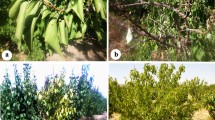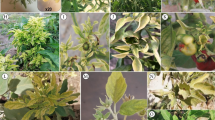Abstract
Spiraea salicifolia is widely grown in China as an ornamental plant, and its roots and young leaves have many medical uses. On the campus of Northwest A&F University, we observed diseased S. salicifolia plants that had yellowed, dwarfed, deformed leaves and other symptoms resembling diseases caused by phytoplasma. This study was aimed at determining the causal agent of the disease. On the basis of phytoplasma-specific DNA amplification by PCR, a phytoplasma infection of S. salicifolia was confirmed. The phytoplasma was related to “Ca. Phytoplasma ziziphi” according to RFLP and phylogenetic analyses. This report is the first of phytoplasma infection of S. salicifolia in China.



Similar content being viewed by others
References
Jung H-Y, Sawayanagi T, Kakizawa S, Nishigawa H, Wei W, Oshima K, Miyata S, Ugaki M, Hibi T, Namba S (2003) ‘Candidatus Phytoplasma ziziphi’, a novel phytoplasma taxon associated with jujube witches’-broom disease. Int J Syst Evol Microbiol 53:1037–1041
Kollar A, Seemüller E, Bonnet F, Saillard C, Bové JM (1990) Isolation of the DNA of various plant pathogenic mycoplasma like organisms from infected plants. Phytopathology 80:233–237
Lee I-M, Gundersen-Rindal DE, Davis RE, Bartoszyk IM (1998) Revised classification scheme of phytoplasmas based on RFLP analyses of 16S rRNA and ribosomal protein gene sequences. Int J Syst Bateriol 48:1153–1169
Li ZN, Zheng X, Wei HJ, Yu XQ, Wu WJ, Wu YF (2009) First report of elm yellows phytoplasma infecting clover in China. Plant Dis 93:321
Min H, Li ZN, Wu YF, Hu SB, Zhang CP, Wu KK (2009) Phytoplasma associated with a witches’ broom disease of Gleditsia sinensis (Fabaceae) newly reported in China. Plant Pathol 4:790
Saitou N, Nei M (1987) The neighbor-joining method: a new method for reconstructing phylogenetic trees. Mol Biol Evol 4:406–425
Tamura K, Dudley J, Nei M, Kumar S (2007) MEGA4: Molecular Evolutionary Genetics Analysis (MEGA) software version 4.0. Mol Biol Evol 24:1596–1599
Yue HN, Sun RH, Wei T, Wu YF (2009) First report of a 16SrV-B group phytoplasma associated with a leafroll-type disease of apricots in northern China. J Plant Pathol 91:500
Zhu SF, Hadidi A, Gundersen DE, Lee I-M, Zhang CL (1998) Characterization of the phytoplasmas associated with cherry lethal yellows and jujube witches’-broom diseases in China. Acta Hortic 472:701–714
Acknowledgments
The study was supported by the National Natural Science Foundation of China (30871625) and the 111 project from Education Ministry of China, No. B07049.
Author information
Authors and Affiliations
Corresponding author
Rights and permissions
About this article
Cite this article
Li, Z., Wu, Z., Liu, H. et al. Spiraea salicifolia: a new plant host of “Candidatus Phytoplasma ziziphi”-related phytoplasma. J Gen Plant Pathol 76, 299–301 (2010). https://doi.org/10.1007/s10327-010-0251-4
Received:
Accepted:
Published:
Issue Date:
DOI: https://doi.org/10.1007/s10327-010-0251-4




